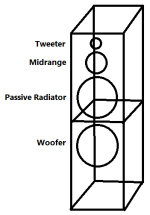I'm designing floor-standing speakers. They contain two separated chambers as depicted on attached. The upper chamber is passive radiator system, and the lower chamber is sealed system. Note that the midrange labeled in the picture is actually a woofer in upper chamber -- No high-pass filter applied to it.
There is no problem with the lower chamber because it's simple sealed design. The problem is the upper chamber. I tried playing with online calculators, they suggested that the PR chamber is tuned at 33Hz, while the sealed chamber is tuned at 58Hz. If they're played the same music signal, will it cause any problems? However, it's similar to car audio system where the front and rear speakers may have different tuning frequency, I think.
There is no problem with the lower chamber because it's simple sealed design. The problem is the upper chamber. I tried playing with online calculators, they suggested that the PR chamber is tuned at 33Hz, while the sealed chamber is tuned at 58Hz. If they're played the same music signal, will it cause any problems? However, it's similar to car audio system where the front and rear speakers may have different tuning frequency, I think.
Attachments
Last edited:
I'd be looking at the relative responses, paying attention to phase.
To some degree, but not necessarily due to the spacing between them.it's similar to car audio system where the front and rear speakers may have different tuning frequency
is this the same project you mentioned in your other thread?
why not continue writing there?
https://www.diyaudio.com/community/...tor-and-sealed-floor-standing-project.399325/
why not continue writing there?
https://www.diyaudio.com/community/...tor-and-sealed-floor-standing-project.399325/
FYI
some driver in a closed enclosure
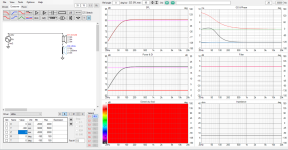
same driver in ported enclosure, which is equivalent to box with passive radiator
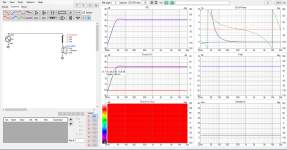
both in series and in parallel with 30cm c-c distance, one in ear level and other below.
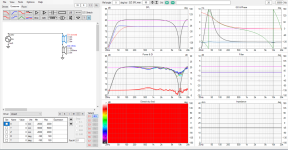
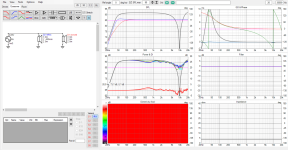
The output at low frequencies is just mix of the two and doesn't seem to be a big deal in graphs. Perhaps for ear in room, no idea. I suspect not a big deal there either, because room dominates the response. Problems would be high in frequency, where path length difference of the two is significant in relation to wavelength. This holds true to any two sources whose bandwidth overlaps no just this kind of case. Note, these are simple ideal omni source results and the high frequency stuff with real drivers on a real box would look different.
There doesn't seem to be obvious downsides or benefits doing a mixed system like that, two equal drivers in two different kind of alignments. Perhaps with a long loud listening session heat accumulation would change the dynamics or something, not sure if it would be now better or worse. I would just build two closed or two reflexes, see no point having both, unless it sums into a high pass slope/Q that works better with room modes with intended listening setup, than either reflex or clsed. As you see the knee on all three is different. Rather than relying this to match the room I'd use DSP with either reflex or closed box system to be able to tune any slope/Q with any setup.
edit.
I see the passive radiator is for midrange driver, which seems odd. I would sell the passive radiator and make mid and bass sealed, three way system.
some driver in a closed enclosure

same driver in ported enclosure, which is equivalent to box with passive radiator

both in series and in parallel with 30cm c-c distance, one in ear level and other below.


The output at low frequencies is just mix of the two and doesn't seem to be a big deal in graphs. Perhaps for ear in room, no idea. I suspect not a big deal there either, because room dominates the response. Problems would be high in frequency, where path length difference of the two is significant in relation to wavelength. This holds true to any two sources whose bandwidth overlaps no just this kind of case. Note, these are simple ideal omni source results and the high frequency stuff with real drivers on a real box would look different.
There doesn't seem to be obvious downsides or benefits doing a mixed system like that, two equal drivers in two different kind of alignments. Perhaps with a long loud listening session heat accumulation would change the dynamics or something, not sure if it would be now better or worse. I would just build two closed or two reflexes, see no point having both, unless it sums into a high pass slope/Q that works better with room modes with intended listening setup, than either reflex or clsed. As you see the knee on all three is different. Rather than relying this to match the room I'd use DSP with either reflex or closed box system to be able to tune any slope/Q with any setup.
edit.
I see the passive radiator is for midrange driver, which seems odd. I would sell the passive radiator and make mid and bass sealed, three way system.
Last edited:
Just move the division wall above the 2nd hole.
I Guess It can be done by acceding from the the real Wall. Just demolish the upper-rear side, a Square, insert the baffle, glue.
At this point, all the Dreams have vanished, so no more PRs for MWs.
The volume of the box for the woofer Is bigger than before After the division re-mastered.
I Guess It can be done by acceding from the the real Wall. Just demolish the upper-rear side, a Square, insert the baffle, glue.
At this point, all the Dreams have vanished, so no more PRs for MWs.
The volume of the box for the woofer Is bigger than before After the division re-mastered.
There is also the concern of the total impedance. You are set for a 2.5 way, and both of drivers are 4 ohm.
Don’t use the mid driver for bass. Period.
The unnecessary cone movement will hamper the midrange, distortion will rise. And why not use the PR for the bass speaker? If you don’t play high SPL, a passive radiator doesn’t have to be that big.
The unnecessary cone movement will hamper the midrange, distortion will rise. And why not use the PR for the bass speaker? If you don’t play high SPL, a passive radiator doesn’t have to be that big.
markbakk
As mentioned earlier, I'm going to build the speakers from existing parts. The cabinet is actually the limitation of the design because the original speaker used dome midrange, not a cone. I use PRs with the midranges because I don't want to build the enclosures for the cone midranges. And I have already had the PRs, so I think to use them instead of building the midrange enclosures.
All,
However, as I did a research further, I'm not sure whether the volume of midrange enclosure is matter if a high-pass filter is applied to the midrange at about 500-600Hz. Because bass is no longer be produced by the midranges, the midrange enclosure volume is no longer matter. Am I correct?
You are correct and regard it as a challenge to mount some small enclosure for the mids. 1 to 1,5 liter is sufficient. Think of drainpipes or cardboard tubes. Or have readymade/3D printed ones.
I had checked for ready-to-use enclosures for sale locally, unfortunately, I couldn’t find any. Modifying cabinets is an even harder job, I think. So, I’m thinking of going back to the original concept — using a 5.25" woofer with an 8" passive radiator.
Last edited:
- Home
- Loudspeakers
- Multi-Way
- Different box tuning, playing the same signal
